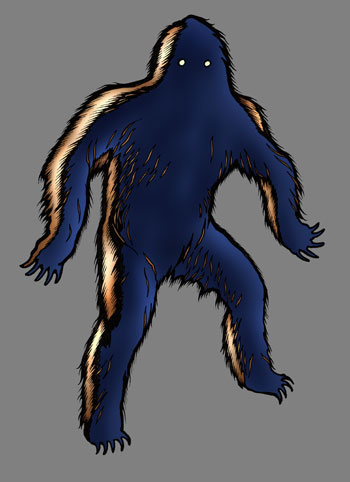
Illustration by Daniel Loxton. Originally published in Junior Skeptic 16, bound inside Skeptic Vol. 10, No. 2 (2003).
When Oxford geneticist Dr. Bryan Sykes decided to tackle the topic of Bigfoot, the cryptozoology community got very excited. Would he identify some new unknown primate? Would the study legitimize research into cryptozoology? Would his evidence give more reason to doubt Yeti and Bigfoot’s existence?
Sykes’ paper Genetic Analysis of Hair Samples Attributed to Yeti, Bigfoot and Other Anomalous Primates appeared in the Proceedings of the Royal Society in August, 2014. (Sykes’ co-authors were Rhettman A. Mullis, Christophe Hagenmuller, Terry W. Melton, and Michel Sartori.) It was the first legitimate large scale DNA survey of anomalous primate1 evidence. (If you’d like to understand why the discredited Melba Ketchum paper doesn’t qualify, I would commend to you the work of Sharon Hill who has compiled a set of well reasoned responses to the various Ketchum claims.) Sykes paper was released in conjunction with a multi-episode documentary called Bigfoot Files, produced by Channel 4.
Prominent folks in the Bigfoot community dismissed Sykes’ effort. Matt Moneymaker of the Bigfoot Field Research Organization (BFRO), famous for Finding Bigfoot, the animal planet “documentary series” which has failed to live up to its title in its six seasons of engrossing forest adventure role-playing, was especially harsh in his criticism of Sykes’ efforts. Moneymaker writes:
Here’s part of the flimflam in the Royal Society paper [a separate short commentary about the Sykes paper—PDF] attempting to whitewash the corruption at the sample inclusion stage:
Of these 58 samples, two were excluded as being non-hair and only 37 of the remaining 56 samples were selected for DNA analysis. The 19 samples excluded from DNA analysis were so designated for a variety of reasons including budget constraints, prioritization of samples of particular historical interest and amount of material available. In this reduced sample, seven of the samples selected for sequencing yielded no DNA. However, all of the 30 samples that did yield DNA contained base-pair sequences that were 100% compatible with known mammal species, though in certain instances the hair sample was reported to have been obtained from a region well outside the species’ known geographical range.”
I could pull this apart all day long … It renders the whole study meaningless. According to this statement, some samples were excluded based on “prioritization of samples of particular historical interest”. That’s a clever way of saying a few samples provided better fodder for the TV documentary, and thus received most of the scientific attention.
Even before that point … “19 of the 57 samples” were “excluded” from the study because it would have taken much longer to find and/or extract sequence-able DNA … in most cases because there was a relatively small amount of material in the sample (i.e. only a few hairs in the sample … like MOST authentic bigfoot hair samples).
After that elimination round, seven (7) more samples yielded “no DNA at all.”
Hence, according to the study itself nearly half of the DNA samples came from species that could not be identified, because those samples did not yield a sufficient amount of DNA to be amplified and analyzed.
Most people don’t understand how it could be more difficult and more expensive to extract DNA from an authentic bigfoot hair sample, and thus why those samples would be more likely to be excluded.
One reason is related to the size of the hair sample (the number of hairs in the sample) and how that increases the difficulty in pulling DNA from the sample. A larger clump of hair will provide more DNA without much fuss, so a larger clump of hair is more likely to be included.
Bigfoot hair is not typically found in large clumps. (Moneymaker, 2014)
But it turns out that Matt was wrong about his conclusions. Sykes responded to this critique in correspondence with Matthew Phelan at Gawker:
Not so. Many samples consisted of only very few, sometimes a single, hair. I had a slight preference for samples with two or more hairs simply because if I had found any to be from an “anomalous primate” I would have had an independent lab test them before publishing the results. That turned out not be necessary. All told I was sent 95 hair samples of which I sent 37 (now 38) for analysis of which 30 (now 31) yielded DNA.
There are many more I would have liked to have tested but, at $1500 a shot, there had to be a budget limit. If the first two unanswered questions about Bigfoot is “Does it Exist” and “What is it” the third is surely “Who’s Paying”. (Sykes, 2014)
In addition to this official BFRO response, there was a widespread disdain for the documentary from many Bigfoot proponents. The general response from skeptical cryptozoological enthusiasts was more positive. This is unsurprising. People are biologically incented to enjoy hearing things they agree with, and this is yet another example of why the scientific process is better than arguing on Internet forums. As much as we amateur enthusiasts enjoy critically examining evidence which disagrees with our premises we have to also pick apart the things we agree with and make sure they’re correct too. I mention this only because it bears repeating every day since we’re naturally disinclined to re-examine things we’re confident about.
Spoiler Alert
How a poor African woman’s plight could be turned into a scary monster story in a human lifetime was deeply disturbing to me.
Sykes’ research and DNA analysis did not find any evidence for mystery primates, but it did find two interesting bits of data. One thing it found was that the famous story of Zana, the Russian “wild woman,” was not a relict hominid but was in fact a human woman of African descent who somehow ended up in Georgia (the country, not the state). I found the story of Zana fascinating and weird before Sykes discovery, but afterwards found it sad and depressing and horribly racist. How a poor African woman’s plight could be turned into a scary monster story in a human lifetime was deeply disturbing to me.
The second bit of interesting data came in the form of bear DNA. According to the Sykes study, some of their DNA samples included sequences which matched bear DNA from a fossilized polar bear from 40,000 years ago. What could this mean? Did it mean that there was a relict population of ancient bears? Did it mean that bears were hybridizing? Did it mean that Yeti sightings were sometimes really sightings of this population of genetically different bears which didn’t behave like “normal” bears of the region? “Gosh—who knows,” wrote Abominable Science! co-author Daniel Loxton in a very preliminary response post at Skepticblog, adding, “Still, let’s just imagine for a second”:
If it were to turn out that some Yeti reports really have recorded an otherwise unknown variety of bear, that would be an enormous discovery—and an utterly astonishing moment in the history of monster studies. It would be a moment of triumph for cryptozoology skeptics, who have said all along that Yetis are really bears; and, simultaneously, it could be a moment of triumph for cryptozoologists, who have said for decades that Yetis are an unrecognized new type of large hairy mammal.
Scientific Responses to Sykes
But was this to be? Challenges soon emerged. In December of 2014, the Royal Society published a response to Sykes’ paper by C.J. Edwards and R. Barnett which concluded that the match to ancient bear DNA is misleading. They conjectured that modern bear populations contain the same genetic markers and the authors suspect that the Sykes finding was due to the DNA sample which was examined having degraded due to its age. Sykes and co-authors Sartori and Melton replied, apologizing for an error in their paper but contending that the DNA samples were not so degraded, being only 10 years old. They also reiterated that the thrust of their research was that the majority of the alleged cryptid hairs came from bears and other non-mystery animals, not from relict hominids or mystery apes.
Today’s Paper
Our discussion so far is meant to provide some context for a new paper published today in the journal ZooKeys, “No need to replace an ‘anomalous’ primate (Primates) with an ‘anomalous’ bear (Carnivora, Ursidae),” in which authors Eliécer E. Gutiérrez and Ronald H. Pine question some of the findings of the research performed by Sykes, et al. They have conducted a detailed comparison of bear DNA data across multiple software approaches and concluded that there is “no evidence of a taxonomically unrecognized bear in the Himalayas.” The authors found that the evidence Sykes’ team used to posit the mystery bear is found in multiple species, and that the sample was more likely from Ursus arctos, a brown bear, “which is known to occur in the Himalayas.” This parsimonious conclusion is consistent with a lengthy history of skeptical commentary identifying Yetis with Himalayan brown bears (summarized for example by Loxton and Prothero in Abominable Science!).
I like science, but it is a human endeavor and therefore subject to all the emotional pressures that come with the territory. I love that scientists are examining the nuances of a paper about cryptozoology. I expect the Sykes team will publish a response to the Gutiérrez and Pine paper in the near future. Rumors suggest there may be interest in another documentary looking for this mysterious Himalayan bear, so it might dampen the interest in that project if science solves the mystery without having to dramatically venture into the mountains.
That being said, I’m in agreement with Gutiérrez and Pine that it seems unlikely that a hunter who shot a bear and got a sample from it would mistake it for a Yeti. Even though there is ample evidence that at least some of the Yeti legend is based on bear misidentification, these majestic and dangerous animals don’t look particularly humanoid once you’ve shot them dead and examined the body. Not knowing the full story of this DNA sample, perhaps the hunter only wounded the animal but the DNA is that of a bear (mystery-bear or not) and not of anything humanoid? That is merely conjecture.
Conclusion
There will likely be more lively debate on the topic of the mystery bear of the Himalayas. Demonstrating that this particular Sykes sample is mundane bear DNA does not prove that there is not a mystery species out there in the snowy mountains adding to the Yeti legends. And Sykes paper still stands as a landmark project of applying scientific methods to a testable question in cryptozoology. I commend all involved for their efforts to close in on answers to such fascinating questions. I’m still open to evidence to the contrary, but for now I’m still convinced that Yeti and Bigfoot are not to be found in the forests and mountains of the Earth, but in the minds of people. Taken together, there is nothing in these papers to suggest otherwise.
References
- Science historian Dr. Brian Regal deserves some credit for popularizing the phrase “anomalous primate” in relation to the field of cryptozoology. He describes the hunt for these creatures and the culture around such research in the excellent book Searching for Sasquatch, and in Pseudoscience: A Critical Encyclopedia.













“Even though there is ample evidence that at least some of the Yeti legend is based on bear misidentification, these majestic and dangerous animals don’t look particularly humanoid once you’ve shot them dead and examined the body.”
I recall a story of 19th-century mountain men freaking out after skinning a bear because the carcass looked like a man.
I am not surprised that this racist story about Zana occurred in Georgia. I had a dinner one evening a few years ago with two English speaking Georgian lawyers and other mining people while working on a geological project near Batumi on the Black Sea. I was asked in all seriousness by two well educated Georgian men how I could live in South Africa, was I not scared of being eaten (and they were not talking about our wild animals). I started asking a number of mischievous, quite loaded questions and got some sadly racist and quite illogical answers. There was a belief among this group that Africans were cannibals to a man. The other Georgians present in the discussion could not speak English (there was ongoing translation of the conversation) but it was fairly clear that this group found black people scary, more animal than human and the colonial concept of Africans being ineducable savages was alive and well. Such is ignorance.
Someone should do a follow-up on Zana. I read the linked piece, and it seems to me that she suffered from a developmental disability exacerbated by her mistreatment.
More details on the new study from one of the authors.
http://doubtfulnews.com/2015/03/new-paper-taking-another-look-at-yeti-data-finds-no-evidence-of-new-bear-in-the-himalayas/
(Thanks, Blake!)